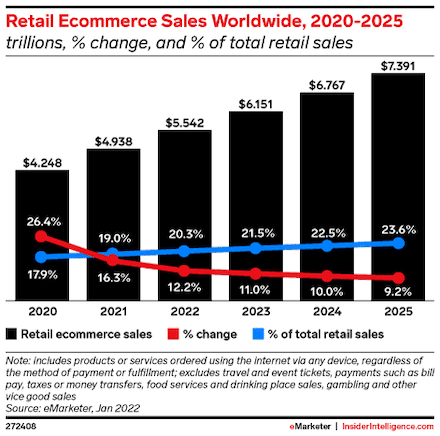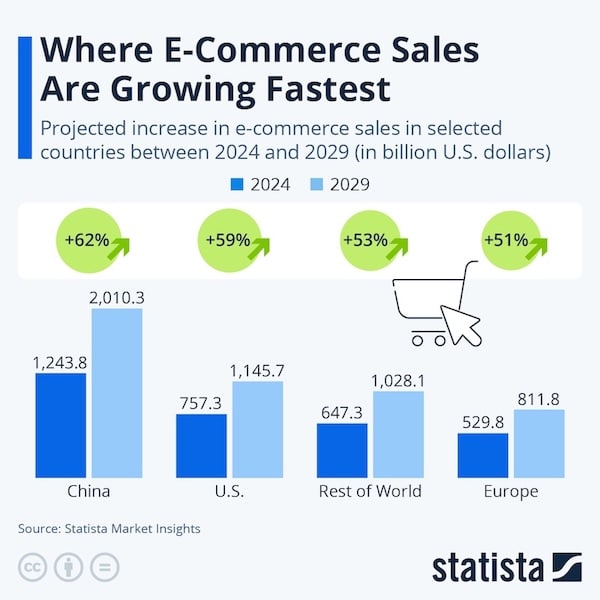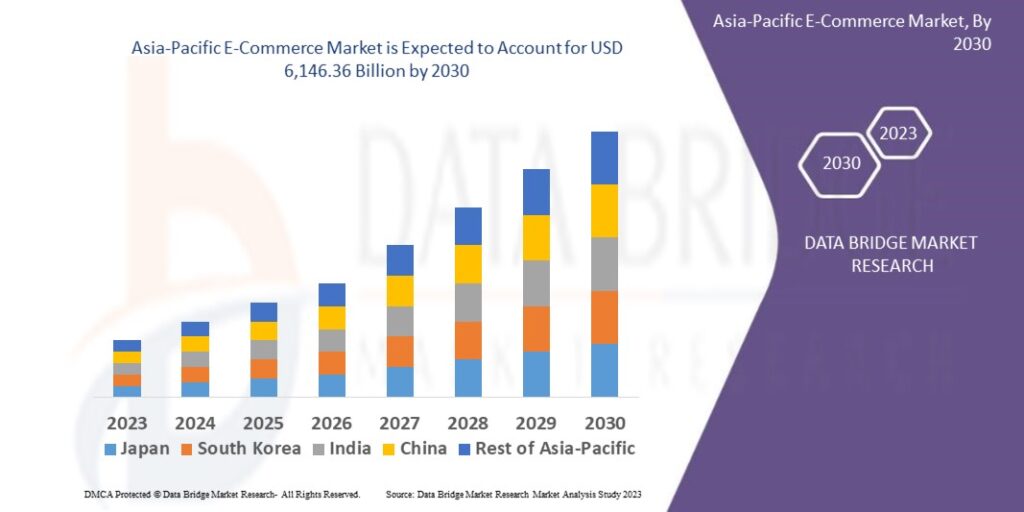Changes in global online retail statistics and trends can overwhelm online businesses. With e-commerce sales hitting record highs and new shopping trends popping up everywhere, it takes time to keep up. But don’t worry—we’ve got you covered.
In this article, we’re diving deep into the “Global Online Retail Statistics and Trends For 2025.” We’ll explore everything from the growth of ecommerce to the rise of mobile commerce and the impact of AI on shopping experiences.
1. $7.4 Trillion Projected Global Ecommerce Sales 2025
Emarketer forecasts that total global online retail sales will reach $7.4 trillion in 2025.
To put that into perspective, nearly one in every four dollars spent in retail worldwide will come from e-commerce. That’s about 24% of total global retail sales, showing how deeply online shopping is becoming part of everyday life.

This growth is occurring because more people worldwide are gaining access to the internet, particularly in developing countries.
For instance, in the African region, internet reach surged from 25% in 2019 to 38% in 2024, allowing millions more to shop online.
Meanwhile, Southeast Asia’s digital economy doubled, from US$ $100 billion in 2020 to over $200 billion in 2023.
A big reason? Better internet access and an increasing number of people using smartphones. In countries like Indonesia, Vietnam, and the Philippines, going online has become part of everyday life, whether it’s for shopping, paying bills, or ordering food. With so many people becoming connected so quickly, it’s no surprise that this region has become one of the hottest markets for online businesses.
But interestingly, even in more mature markets like the U.S. and Europe, ecommerce is far from slowing down. Statista’s forecasts indicate that these regions are expected to grow by 51% to 59% during the same period.

While these regions may be mature, they’re far from being saturated. The next few years are expected to bring new technologies, improved customer experiences, and fresh growth opportunities—all pointing to one thing: ecommerce isn’t slowing down anywhere.
2. Global Retail Market: Surging Sales and Future Projections
In 2022, the global retail market generated sales of over 27 trillion U.S. dollars, forecasted to reach over 30 trillion U.S. dollars by 2024.
As we look ahead, the future appears even brighter. Projections indicate that by 2024, the market is set to soar even higher, with sales anticipated to surpass the 30 trillion U.S. dollar mark.
3. Share of E-commerce in Global Retail Sales
In recent years, the e-commerce sector has seen remarkable growth, capturing an increasing share of the global retail market.
In 2022, the e-commerce sector’s share of total global retail sales was around 18.9%, and this share is likely to increase even more in the coming years.
In fact, predictions indicate that the online segment will account for nearly a quarter of total global retail sales by 2027.

This shift indicates a fundamental change in consumer behavior as more people turn to online shopping for its convenience and accessibility.
Several factors contribute to this exponential growth. Advancements in technology and the ready accessibility of smartphones have made online shopping more prevalent than ever.
Additionally, the COVID-19 pandemic accelerated the shift towards e-commerce, as lockdowns and social distancing measures prompted consumers to shop online.
4. Rapid Growth of Asia-Pacific’s E-commerce Market
The e-commerce market in the Asia-Pacific region has been experiencing an impressive surge in recent years. In 2022, the market was valued at a whopping $2,980.11 billion, and it’s not slowing down anytime soon.
Experts predict that by 2030, the market will more than double, reaching an estimated $6,146.36 billion. This growth translates to an annual compound growth rate (CAGR) of 19.20% during the 2023-2030 forecast period.

Several factors are driving this expansion. The region’s increasing internet usage, coupled with a growing middle class, is boosting online shopping. Additionally, the widespread use of smartphones and mobile payment systems makes e-commerce more accessible and convenient for consumers.
China, in particular, is leading the charge as the largest e-commerce market in the world. But it’s not just China—countries like India, Japan, and South Korea are also seeing a surge in online retail sectors.
5. Dominance of China and the US in the Global Online Commerce Market
China and the United States are the giants of the e-commerce world.
In 2023, China emerged as the world’s top e-commerce market, with total online sales exceeding the $3 trillion mark.

This gives an idea about the vast consumer base and the country’s rapid adoption of digital shopping platforms.
The United States, just a little behind, contributes significantly to global e-commerce spending. Together, these two countries accounted for more than $4.1 trillion in e-commerce sales.

These massive figures highlight China’s and the US’s dominance of the global online retail sector and their role in shaping global e-commerce trends.
Businesses looking to succeed in e-commerce must pay close attention to the strategies and innovations emerging from China and the US, as they often set the pace for the rest of the world.
6. Generational Differences in Online Retail Spending
When it comes to online shopping, there are apparent differences between the generations.
Generation Z, born between 1995 and 2003, is leading the charge in the digital marketplace. This could be due to their comfort with technology and a preference for the convenience of online shopping.
Here’s the spending breakdown:
- Generation Z (born between 1995 and 2003) is 16.4% more likely to shop online than all shoppers.
- Millennials (born between 1980 and 1994) are 12.7% more likely to shop online than the average consumer. This generation grew up with the internet and has embraced online shopping daily.
- Generation X (born between 1965 and 1979) is 9.09% less likely to shop online than all shoppers. This could be due to a preference for seeing products in person before purchasing or concerns about online security.
- Baby Boomers (born between 1946 and 1964) are 27.3% less likely to shop online than the average consumer.
In summary, younger generations are more inclined towards online shopping, while older generations tend to stick to traditional shopping methods.
7. Mobile Commerce Growth Projections for 2025
Mobile commerce, or m-commerce, is witnessing an exponential growth.
Statistics suggest that by 2024, nearly 43% of all e-commerce sales will be made through mobile devices. This number is likely to climb even higher to 44.2% by 2025.

What does this mean for shoppers and businesses alike?
Simply put, consumers prefer the convenience of shopping on the go over more traditional shopping, making mobile-optimized shopping experiences more critical than ever.
8. The Rise of Digital Payment Systems in E-commerce
In 2022, digital payments took off, with 89% of people worldwide starting to use them. This is a huge jump in the number of online consumers going digital with their money.
The same study revealed that over two-thirds of Americans anticipate having a digital wallet within the next two years, and it’s probable that many will have more than one.
You can attribute this rise in digital payments to consumers increasingly seeking quick and convenient payment options.
This paved the way for digital payment systems like Apple Pay, Google Pay, PayPal, Venmo, Alipay, and Square.
And why not? These platforms offer a smooth, simple, and secure way to make transactions, catering to shoppers’ needs for speed and simplicity.
One of the most exciting trends in digital payments is the emergence of Buy Now Pay Later (BNPL) methods. These options allow consumers to purchase and pay for products immediately over time, often interest-free. This flexibility has made BNPL a favorite among shoppers, particularly for larger purchases.
9. Global Online Retail Spending Boost: The Impact of Omnichannel Strategies
Retailers leveraging omnichannel strategies are witnessing massive revenue and growth.
According to Omnisend, retailers adopting omnichannel strategies see a 287% higher purchase rate than single-channel platforms.

This means that customers who can interact with a brand through various platforms—be it in-store, online, or through mobile apps—are more likely to make a purchase.
But the advantages continue beyond there. Customers who engage with brands through multiple channels shop 1.7 times more than shoppers who only shop through a single channel.
So, what makes omnichannel such a success?
Omnichannel retail is all about providing a seamless and integrated shopping experience. Whether a customer is browsing on their mobile, clicking through a website, or wandering through physical aisles, it ensures a consistent and cohesive journey.
This integrated approach meets customers where they are, making it easier and more enticing for them to purchase.
10. Embracing Sustainability: The Rising Demand for Eco-Friendly Products and Packaging
The new generation is serious about sustainability. For them, it’s more than just a trend—it’s a movement.
A 2020 McKinsey US consumer sentiment survey revealed a striking insight: 60% to 70% of respondents stated they’re willing to pay extra for products with sustainable packaging.
This speaks volumes about the growing consciousness among consumers concerning the environmental impact of their purchasing decisions.
The demand for sustainable products extends beyond packaging.
In a survey report, 73% of consumers claimed they want to alter their shopping habits to reduce their environmental footprint. This increasing awareness drives businesses to rethink their practices and incorporate eco-friendly solutions into their products and packaging.
Remember, sustainable packaging is not just about using recyclable materials. It’s also about minimizing waste, reducing carbon emissions, and promoting a circular economy.
Companies are exploring innovative options like biodegradable materials, refillable containers, and minimalist designs to meet consumer expectations and contribute to a healthier planet.
11. The Role of AI and Personalization in Global Online Retail Spending
Retailers are now using AI to offer personalized experiences that cater to the unique preferences of each shopper.
Since 2020, there has been a staggering 159% increase in AI category reviews, highlighting the growing reliance on this technology in the retail industry.
Moreover, nearly 54% of retail marketers use AI-driven personalization across various channels to fuel their business growth.

This helps businesses and marketers to gain deeper insights into customer behavior, allowing them to personalize their offerings and interactions in real-time. By understanding what customers want and how they shop, businesses can create more relevant and engaging experiences that resonate with their audience.
AI in e-commerce personalization isn’t just limited to personalizing customer experience and understanding customer behavior.
A significant number of marketers are also leveraging AI to:
- Interact with their customers in real-time across multiple channels (52%)
- Identifying their target audience across various touchpoints (48%)
- Target qualified leads to turn them into buying customers (41%).
From personalized product suggestions to customized marketing messages, AI helps retailers build stronger customer connections, ultimately increasing loyalty and sales. As AI technology continues to evolve, its role in shaping the future of e-commerce personalization is set to become even more significant.
Conclusion: Navigating the Future of Online Retail
We discussed the global online retail statistics and trends for 2025. It’s clear that e-commerce is not just thriving—it’s revolutionizing how we shop and do business. The rise of mobile commerce, the importance of personalized experiences, and the increasing influence of omnichannel are just a few factors driving this evolution.
For businesses, staying ahead means embracing innovation, understanding your audience, and adapting to changing trends. For consumers, it’s about enjoying the convenience, variety, and opportunities that online shopping brings.
Global Online Retail Statistics and Trends FAQs
What is the worldwide retail ecommerce forecast for 2025?
Global retail eCommerce sales are forecast to reach $7.4 trillion in 2025, according to eMarketer. This will account for nearly 24% of all global retail spending, showing how online shopping is becoming a dominant force in the retail landscape.
What is the ecommerce market value 2025?
The projected value of the global eCommerce market in 2025 is $7.4 trillion, driven by increased internet access, mobile commerce, and AI-powered shopping experiences across both emerging and mature markets.
What is the estimated number of digital buyers worldwide in 2025?
By 2025, the number of digital buyers worldwide is expected to surpass 2.77 billion, representing over 33% of the global population. This growth reflects broader internet penetration, especially in regions like Africa and Southeast Asia.



